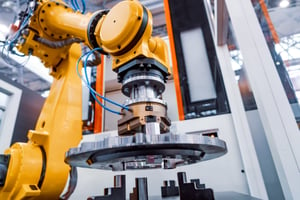How will the U.S. economy rebound from the COVID-19 pandemic?
According to an April 10, 2020, article published by Forbes, the key to unlocking this mystery could involve more businesses embracing the robotics.
Written by Shahin Farshchi, the article — entitled Expect More Jobs And More Automation In The Post-COVID-19 Economy — begins by summarizing how this crisis has forced numerous businesses, factories and warehouses to close to protect the health of their employees. As a result, thousands of loyal employees have lost their jobs and many businesses have been forced into either economic limbo or financial ruin.
 Farshchi cites a report by the International Federation of Robotics that concluded that decreasing production and maintenance costs have made the prospect of converting to robotics much more accessible to businesses across the globe.
Farshchi cites a report by the International Federation of Robotics that concluded that decreasing production and maintenance costs have made the prospect of converting to robotics much more accessible to businesses across the globe.
The article illustrates the part automation could play in helping the U.S. economy bounce back from this social and economic crisis:
- According to the management consulting firm McKinsey & Company, by 2030, up to 30% of all jobs in the U.S. will become automated.
- McKinsey also predicts that automation and artificial intelligence will play a major role in helping businesses increase productivity and expand their overall economic growth
- The World Economic Forum estimates that emerging professions resulting from automation could account for 6.1 million jobs globally between 2020 to 2022.
- According to the WEF, automation will generate many new opportunities for fulfilling people’s potential and aspirations.
- Businesses that embrace robotics are more capable of protecting their employees from being exposed to pathogens during future pandemics.
Are humans in danger of being replaced by automation?
 Farshchi points out that instead of replacing humans in the workforce automation protects them by taking over tasks that were difficult and dangerous, citing inventor William Seward Burroughs. When Burroughs created the first adding machine in 1885, skeptics were fearful that his creation would put accountants out of work. On the contrary, his invention made their job easier by sparing them from spending hours upon hours tediously checking ledgers for errors.
Farshchi points out that instead of replacing humans in the workforce automation protects them by taking over tasks that were difficult and dangerous, citing inventor William Seward Burroughs. When Burroughs created the first adding machine in 1885, skeptics were fearful that his creation would put accountants out of work. On the contrary, his invention made their job easier by sparing them from spending hours upon hours tediously checking ledgers for errors.
Where can I get the training I need to work in the robotics industry?
Beginning Autumn 2020, Hocking College will offer an Advanced Manufacturing and Engineering Technologies degree program. The program is designed to prepare students to enter the advanced manufacturing and robotics industry
What skills do I need to succeed in this program?
- Good oral and written communication skills
- Basic computer skills
- Organizational skills
- Critical-thinking skills
- Willingness to learn
What skills will I learn in this program?
Students who enroll in Hocking College’s Advanced Manufacturing and Engineering Technologies program will study the following subjects over four semesters:
 Architectural design
Architectural design- Automation techniques
- Mechanical design
- Industrial robotics
- Real-world advanced manufacturing processes
- Robotics programming
- Robotics applications
- Supervision and leadership
What kind of salary do people in the advanced manufacturing field make?
According to the U.S. Bureau of Labor Statistics and Neuvoo, the average salaries for specific positions in the advanced manufacturing field are:
- The average salary for a robotics technician was $53,235.
- The average annual salary for a CAD technician/designer/drafter is $52,650.
- The median pay for an electronics technician is $64,330.
- Medical equipment repairers have a median pay of $49,210.
How can I get more information on this program?
For more information on this program, contact Advanced Manufacturing and Engineering Technologies Program Manager Baqer Aljabr by email at aljabrb@hocking.edu or by phone at 740-753-6127.



